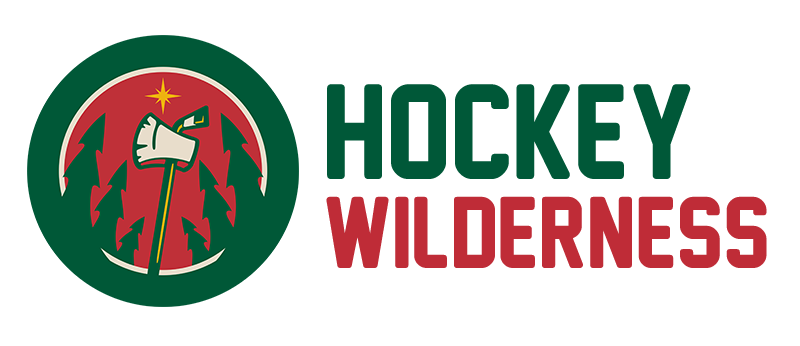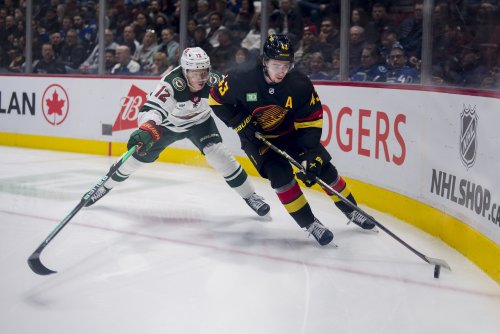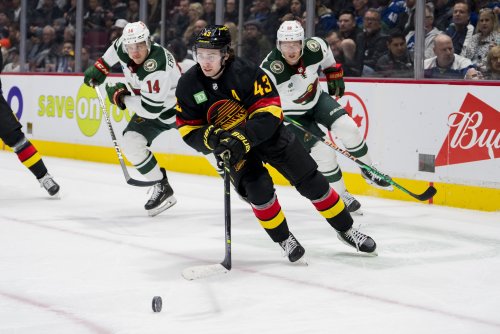.jpg.4ff06938075ff49a2500841bce1c3157.jpg)
As the common saying goes, “Money is the root of all evil.”
For all of the pocket-watchers who hate the Filip Gustavsson contract, that sentiment has to be top of mind. They also might cite Devan Dubnyk’s contract -- a deal that aged so poorly that Minnesota traded him in the 2020 offseason. They only upgraded from a fifth to a seventh-round pick, and even to do that, the Wild had to retain the maximum 50% of Dubnyk’s salary.
However, the popular phrase is actually a shortening of the original bible verse, 1 Timothy 6:10, which reads, “For the love of money is the root of all evil: which while some coveted after, they have erred from the faith, and pierced themselves through with many sorrows.”
Perhaps those who are wailing and gnashing their teeth over paying a starting goaltender a below-market-rate contract should stop coveting after those extra cap dollars and ask the real question.
Will the Gustavsson contract age as poorly as Devan Dubnyk’s?
To save Wild fans from those many sorrows, I’ll dive into that comparison.
First, compare the two contracts. Dubnyk signed his extension in the 2015 offseason, and it started in the 2015-16 season. It carried a five-year term at an average annual value (AAV) of $4.33 million. The Wild signed Gustavsson during the 2025 training camp, but the contract kicks in during the 2026-27 season. His contract has an identical term, but at a $6.8 million AAV.
Comparing those cap hits at face value is unfair because the salary cap is so much higher now than it was five years ago. If we translate them to a percentage of the salary cap in Year 1 of each deal, they look much closer. Gustavsson’s takes up 6.54% of the 2026-27 salary cap, while Dubnyk’s was 6.07% of the salary cap. In a sense, that means that Gustavsson’s deal is only 7.7% more expensive, after adjusting for cap inflation.
However, even that sells the Gustavsson deal short. Because the NHL has already projected the 2026-27 and 2027-28 salary caps, Bill Guerin knows that the cap will increase in the second year of the deal. On the other hand, Chuck Fletcher, the Wild GM who signed Dubnyk’s contract, didn’t know the Year 2 cap number for Dubnyk’s extension.
Fletcher should have assumed a much tighter cap environment than what today’s NHL enjoys. He only learned of the first-year salary cap four days before extending Dubnyk -- an unusually small increase of only 3.5%.
Even if Fletcher projected the cap to rebound in future seasons, Guerin can get more aggressive. The cap increase in Year 2 of Gustavsson’s deal is locked in at 9.1%. By comparison, the three seasons before the Dubnyk deal saw cap increases of 7.2%, 7.3%, and 3.5%. That speaks to a stagnating business environment for the NHL, which Fletcher should have leveraged in negotiations with Dubnyk.
Gustavsson’s extension will probably take up the same percentage of the salary cap as Dubunyk’s did over the contract lifetime.
Another factor that compounds against the rising salary cap is the age of each player in the first year of the contract. Dubnyk’s extension covered his age-29 through age-33 seasons, while Gustavsson’s covers his age-28 through age-32 seasons.
This isn’t some trick of the birthdays, either. Dubnyk was a full 13 months older than Gustavsson in the first year of his deal, when compared to the first year of the Swede’s new contract.
A one-year age difference might seem small, but aging is not a linear process. It’s best understood in two ways. Either as an exponential decline, an “age curve” that implies performance falls off more and more every year, or as an “age cliff,” in which a player's performance drastically declines with little warning. In the latter case, Gustavsson’s contract is a better risk to manage. In the former case, this compounding effect works nicely when combined with the inflating salary cap.
Since the contract length is identical, the two goaltenders’ ages are a crucial point in favor of Gustavsson’s contract.
Finally, let’s get into the two goaltenders’ performance. Which of these guys is actually better?
When the Wild traded Dubnyk in 2020, he was coming off two seasons in which he performed well below an average goaltender despite making a starter’s salary. His 2018-19 campaign was particularly painful, but his 2019-20 season was similarly poor.
However, in all fairness to Chuck Fletcher, it’s impossible to be certain of exactly how a player will perform as his contract ages. For that reason, let’s compare Gustavsson’s performance to Dubnyk’s in the three seasons before they signed their extensions.
That three-season sample includes 142 games and 633 five-on-four minutes for Gustavsson, all in Minnesota. Dubnyk played 130 games and 600 five-on-four minutes for Minnesota, the Nashville Predators, and the Edmonton Oilers. It should be a large enough sample to rely on these numbers with confidence, despite the up-and-down nature of goaltending.
Since Gustavsson signed his contract a full calendar year before entering the first year of the contract, this will slightly inflate his numbers since we don’t yet know the results of his age-27 season. That’s a key difference in comparing their pre-signing seasons, since Gustavsson’s sample will cover his age 24 through 26 seasons and his contract starts at age 28, while Dubnyk’s sample covers his age 26 through 28 seasons and his contract started at age 29.
With that caveat, Gustavsson’s numbers are meaningfully better than Dubnyk’s.

Goaltending performance data courtesy of MoneyPuck.com.
At five-on-five play, Gustavsson and Dubnyk saw similar expected goals (xG), a measure of shot danger which accounts for shot location and how quickly the puck moved from the previous event (usually a pass or turnover).
It doesn’t account for screens since player location data is not publicly available. Still, it’s the most stable metric for evaluating goaltenders. It’s better than save percentage or goals-against average, since it doesn’t punish goaltenders who play behind bad defenses.
Despite their similar workloads, Gustavsson outperformed Dubnyk by about 5.7 goals saved above expected (GSAx) per season. That sounds small, but Gustavsson’s 7.5 GSAx versus Dubnyk’s 1.8 GSAx would have been the difference between the 19th-best and 35th-best goaltender last year (top 64 goaltenders by games played).
Expanding that analysis to all situations, Gustavsson’s three-season average would have ranked 21st in the league last year, while Dubnyk’s three-season average ranked 30th.
Dubnyk performed slightly better in penalty kill situations, but that wasn’t true if we filter down to only high-danger chances. Those are defined as the top-third of shots by xG -- shot attempts with at least a 20% chance to become goals.

High-danger saves are especially important on the penalty kill, when opposing offenses design plays specifically to generate those chances. Gustavsson’s high-danger five-on-four numbers aren’t drastically better than Dubnyk’s, but it helps reduce the concern about Gustavsson’s penalty kill performance going forward.
Even if Gustavsson’s 2025-26 performance declines with age compared to his last three seasons, it looks like Guerin signed a meaningfully better goaltender than Fletcher did.
Better performance, a younger goaltender, and a healthier salary cap environment all compound against each other when considering Gustavsson’s future performance compared to Dubnyk.
The Dubnyk contract sets a low bar in aging contracts. Minnesota essentially dumped Dubnyk’s cap hit in the final year of the deal, and they carried his poor performance for two seasons before that.
Just because Gustavsson clears that bar does not make the contract a steal. It’s nothing close to the sweetheart deals signed by Matt Boldy or Joel Eriksson Ek.
However, anybody complaining that the Gustavsson contract is history reincarnate is simply wrong. They’re just pointing at the new goalie contract and saying it’s the same as the last one, because it’s all that they’ve seen before.
Old wounds are slow to heal. With any luck, Gustavsson’s contract won’t reopen them anytime soon.
Think you could write a story like this? Hockey Wilderness wants you to develop your voice, find an audience, and we'll pay you to do it. Just fill out this form.
-
 2
2
-
 1
1








Recommended Comments
Join the conversation
You can post now and register later. If you have an account, sign in now to post with your account.
Note: Your post will require moderator approval before it will be visible.